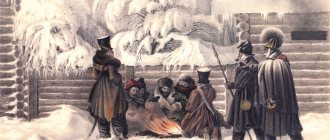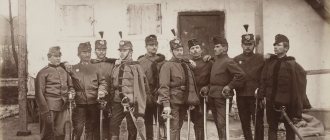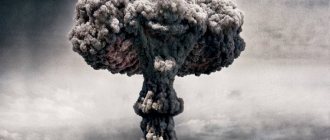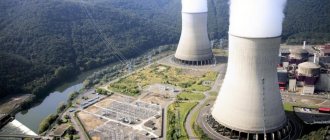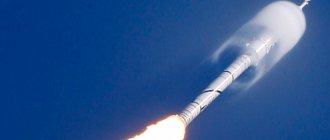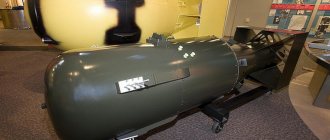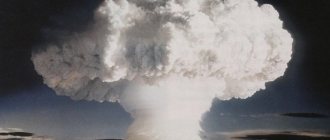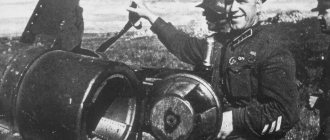The crown of Europe's first post-war summer marked an important meeting of the heads of state of the Anti-Hitler coalition. It had to determine a lot for the countries and peoples that had just emerged from the war. But on July 16, 1945, in the desert region of the American state of New Mexico, they took a preemptive step - they detonated a nuclear explosive device.
In other words, the world's first atomic bomb was detonated. Instead of the previously familiar chemical explosives (TNT, trinitrotoluene and its varieties), plutonium-239 was used in the first American “Gadget”. This artificially produced material (it does not exist in nature) provided enormous explosive power due to the chain reaction of fission of atomic nuclei and the release of intranuclear energy.
The first bombs that were created in the Los Alamos laboratory under the leadership of Robert Oppenheimer and Leslie Groves, as General Groves himself admitted, were immediately sought for use by the Joint Chiefs of Staff. The pragmatic generals resolutely refused a demonstrative explosion on a deserted atoll in the ocean, as bomb scientists initially proposed, and chose four real objects on the territory of Japan, with which the war was still ongoing.
The following were targeted: the arsenal in the city of Kokura (Japan's largest center of military production and supply); the city of Hiroshima (as a center for the transport of ground forces by sea and a point for the formation of sea convoys); Niigata (large port, metallurgical and oil refineries, tanker refueling point).
Kyoto is also a cultural and industrial center with a population of about a million people, in the past it was the capital of Japan. The urban area of Kyoto allowed that the area of visible destruction “would be inside its territory,” and this, the generals cynically reasoned, “will help determine the impact force of the bomb.”
The news that “the birth was successful” dramatically changed the mood within the American delegation at the conference in Potsdam
However, the inclusion of Kyoto in the list of intended targets for atomic bombing was not supported by then US Secretary of Defense Henry Stimson. “His arguments,” Leslie Groves admits in her memoirs, “were based on the fact that this was the ancient capital of Japan, a historical city, a place of enormous religious significance for the Japanese. He himself visited Kyoto when he was Governor-General of the Philippines, and this city shocked him with its monuments of ancient culture.”
Whether Stimson was himself in Hiroshima and Nagasaki, I don’t know. I had the chance once. And what happened to these cities on August 6 and 9, 1945 is now known all over the world. The Americans dropped an atomic bomb filled with uranium-235 on Hiroshima and called it “Baby.” And the “Fat Man,” which burned Nagasaki three days later, was one-on-one with the very first charge that was tested on July 16 at the deserted Alamogordo airbase.
Atomic monopoly and general temptation
The news that “the birth was successful” dramatically changed the mood within the American delegation in Potsdam. According to British Prime Minister Winston Churchill, US President Truman, who initially smiled and shook hands with Stalin, suddenly became irritable and began to “tell the Russians what and how to do.”
Today, when three quarters of a century separates us from this event, it would not be amiss to recall: from July 16, 1945 until August 29, 1949, only the United States possessed nuclear weapons. And during the years of this monopoly there was a temptation to take advantage of it. In the generals' heads and on the staff maps, plans were drawn, one darker than the other.
Back in the days when the Big Three met in Potsdam, the Joint Chiefs of Staff met time after time in the Pentagon. At these secret meetings, a fundamentally new military policy was developed.
One of the KNS statements said: “In the past, the United States has been able to maintain the tradition of never striking until it has been struck.” In the future, the same document noted, the armed forces must be able to “stun the enemy and destroy his will and ability to wage war before he can inflict significant damage on us.”
This general military-political orientation found its practical embodiment in the directives of the Joint Chiefs of Staff JCS-1496 of July 19, 1945 and JCS-1477/1 of October 30 of the same year, in the directive JCS 1691/7 of June 30, 1947.
In March 1946, hawkish tendencies were fueled by the Fulton speech of Churchill, who had already resigned as Prime Minister. By September 1949, when the first nuclear test in the USSR was not yet officially known, the concept of delivering a first strike with atomic weapons in the event of war was introduced into official US military policy by Truman's secret directive NSC-57.
The data I rely on was provided by American physicists Mikio Kaku and Daniel Axelrod in their study “USA: Betting on Victory in a Nuclear War. Secret plans of the Pentagon." Before others, this book, freely published in English, was able to become acquainted with and even translated into Russian at the Main Intelligence Directorate of the General Staff of the Armed Forces of the USSR. We got acquainted, translated from English, printed a certain number of copies and... labeled each one “For official use.” And only five years later, already in Russian realities, they decided to declassify it on the special instructions of the head of the 12th Main Directorate of the Ministry of Defense of the Russian Federation.
A growing fireball and blast wave 0.016 seconds after the detonation command. July 16, 1945. Photo: Gettyimages
What a fragile brink the world was on long before the Cuban Missile Crisis is evidenced, for example, by the following admission: “During the Korean War, American Air Force pilots were authorized to independently use tactical nuclear weapons. Commanders with the rank of captains and majors themselves had to determine whether the situation had reached a critical level or not ... "
The war on the Korean Peninsula, note, began in the summer of 1950. By that time, the Soviet leadership officially declared that the US monopoly on nuclear weapons no longer existed. But we must face the truth. According to recently declassified documents of the USSR Atomic Project, at the beginning of 1950 our country had only single copies of nuclear devices. At the pilot plant in KB-11 (now the Russian Federal Nuclear Center All-Russian Research Institute of Experimental Physics, Sarov, Nizhny Novgorod Region), by the end of 1949 they managed to produce two more “501 products” - similar to the first one that was blown up on August 29, 1949 at the Semipalatinsk tower polygon. Over the twelve months of 1950, nine more RDS-1s were assembled using the same scheme, and the following year - twice as many, eighteen.
However, at this moment, the Soviet atomic arsenal was significantly inferior to the American one: by 1950, there were already over four hundred nuclear bombs, and they were mass-produced. At first, Soviet scientists, designers, engineers and technologists had to play catch-up.
A notable and, in some sense, turning point on the path to nuclear parity with the United States was the test of a hydrogen bomb on August 12, 1953. The Americans announced such a test almost a year earlier. But they, as American experts put it, blew up a “house with tritium,” that is, a bulky laboratory sample the size of a three-story house. And in the USSR they tested a compact, almost ready-to-use combat device: the first such hydrogen bomb was tested by dropping it from a carrier aircraft.
The concept of a first strike with atomic weapons in the event of war was already in Truman's secret directive NSC-57
The resulting de facto parity in nuclear weapons between the USA and the USSR/Russia, supported by international treaties and bilateral agreements, remained for many years a guarantee of strategic stability and was a deterrent against the outbreak of a new world war. And now this system of checks and balances is being subjected to new global tests.
"Tsar bomb". October 30, 1961
This thermonuclear aerial bomb was developed in the USSR in 1954-1961. a group of nuclear physicists under the leadership of Academician of the USSR Academy of Sciences I.V. Kurchatov. This is the most powerful explosive device in the history of mankind. The total energy of the explosion, according to various sources, ranged from 57 to 58.6 megatons of TNT.
Khrushchev personally announced the upcoming tests of a 50-megaton bomb in his report on October 17, 1961 at the XXII Congress of the CPSU. They took place on October 30, 1961 within the Sukhoi Nos nuclear test site (Novaya Zemlya). The carrier aircraft managed to fly a distance of 39 km, but despite this, it was thrown into a dive by the shock wave and lost 800 m of altitude before control was restored.
The main political and propaganda goal set before this test was a clear demonstration of the Soviet Union's possession of unlimited weapons of mass destruction - the TNT equivalent of the most powerful thermonuclear bomb at that time in the United States was almost four times smaller. The goal was fully achieved.
Is there light at the end of the tunnel?
How the “birth in Alamogordo” turned out for the entire post-war world order and how today they are trying to contain the process of proliferation of nuclear weapons, we analyze together with PIR Center experts, scientists and diplomats.
More recently, speaking at the online session of the Primakov Readings, the head of the Center for International Security at IMEMO RAS, Alexei Arbatov, warned that the modern world “could be thrown back to the 1950s, when there was nuclear deterrence, but there was no arms control system.” . Then, Alexey Arbatov recalled, the world had reached its breaking point, and the Cuban Missile Crisis of 1962 was caused by an unrestrained arms race. “Only a miracle saved the world from disaster,” the expert said.
What do we see now? Expeditionary trips between Russia and the United States within the framework of the Strategic Arms Reduction Treaty have been stopped. The Conference of the Parties to the Treaty on the Non-Proliferation of Nuclear Weapons has been postponed for a year. Washington announced its decision to withdraw from the Open Skies Treaty, and a crisis is growing over President Trump's position regarding the plan to resolve the Iranian nuclear program.
Moreover, according to Arbatov, in the United States there was even serious talk about withdrawing from the Comprehensive Nuclear Test Ban Treaty. “It was concluded in 1996 and took 33 years to prepare. It is the greatest achievement that since 1996, no country except North Korea has conducted nuclear tests, and North Korea stopped last year... But if the United States leaves, then not only this treaty will collapse, but also the NPT, because these two the treaties are very closely related,” warned the head of the IMEMO Center for International Security.
Academician of the Russian Academy of Sciences Sergei Rogov, scientific director of the Institute of the USA and Canada, also agrees with him on many points. In his opinion, if the START III treaty is not extended or an adequate replacement is not proposed, “then the nuclear arms control regime, which has existed for several decades and was the basis of strategic stability, will completely collapse.” And without this kind of agreement, “nuclear chaos will begin, a game without rules,” when everyone acts according to their own concepts and ideas, as was the case at the very beginning of the nuclear arms race.
“Of course, the termination of the START-3 treaty is not the end of the world,” Interfax quotes academician Rogov. “But the absence of this treaty will have extremely negative consequences and may ultimately lead to the end of the world, if by this we mean nuclear war.”
Is there an alternative to this? So as not to count and control, but to do away with atomic bombs, warheads and their carriers once and for all?
“In order to rid the world of nuclear weapons, there must be universal harmony, which, unfortunately, can hardly be expected,” said the chairman of the PIR Center board and co-chairman of the international club “Trialogue”, retired lieutenant general Evgeniy Buzhinsky.
To support his position, he refers to past experience and events of recent years. All conflicts, US actions to destroy existing international political, trade, economic and other mechanisms, strengthening the military presence in Europe - all this interferes with the process of general disarmament, the expert believes.
To rid the world of nuclear weapons, universal harmony must come, and this is not predicted in the foreseeable future on both sides of the ocean
“What might a plan for general disarmament look like? - Evgeny Buzhinsky asks the question and answers it himself. — Such a plan already exists - this is article six of the NPT, according to which countries that have nuclear weapons are obliged to strive for disarmament. It is pointless and useless to force them into a certain time frame. Even if we set a goal of reducing nuclear weapons by a third by 2025, the slightest complications in international relations could completely stop the process. Difficulties will arise in one of the “hot spots”, be it in the Middle East or Southeast Asia. Key players are likely to intervene in the regional crisis: the United States, Russia or China - there will be a clash of interests that will lead to a halt in the disarmament process. In this regard, I believe that complete nuclear disarmament is currently impossible.”
The PIR Center expert recalled a scene from the series “Seventeen Moments of Spring,” where Oleg Tabakov’s character says: “Müller is immortal, just as detective is immortal in this world.” General Buzhinsky applies the same words to nuclear weapons.
The “mushroom” season, opened 75 years ago in Alamogordo, was continued in Nevada, near Semipalatinsk, on Novaya Zemlya, Moruroa Atoll and in other not so well-known nuclear testing sites. Photo: Gettyimages
How it was
I was extremely interested in carrying out the test as scheduled, because I knew what significance this event could have in the Potsdam negotiations. In addition, every extra day of delay in the test meant an extra day of war. And not because we will be late in making bombs, but because a delay in the Potsdam decisions will delay Japan's response and, therefore, delay the day of the atomic bombing.
From a purely technical point of view, it was also desirable to carry out the test as quickly as possible, since every extra hour that the electrical connections were exposed to a very damp environment increased the likelihood of a misfire. The electrical connections in the devices and in the wires leading to them, which were not made as carefully as the electrical part of the bomb itself, could be even more damaged. In addition, every extra hour increased the likelihood that someone would attempt to interfere with the test. Our people were in a state of extreme nervous tension, and the possibility was not excluded that one of them would not be able to withstand it. As a result, Oppenheimer and I agreed not to postpone the test for a day, but to wait another two hours.
Our preparations were simple. Everyone was ordered, when the count reached zero, to lie down with their face to the ground and their feet in the direction of the explosion, close their eyes and cover them with their palms. As soon as the explosion occurred, you were allowed to get up and look through the smoked glass that everyone was equipped with... I lay on the ground between Bush and Conant and thought only about what I should do if nothing happened when the score was “zero”...
The explosion occurred at 5:30 am. There was a feeling of a very bright light filling everything around, and when I turned around, I saw the now familiar picture of a fireball. My first reaction, as well as Bush's and Conant's, while we were still sitting on the ground watching this spectacle, was a silent exchange of handshakes.
Shortly after the explosion, Farrell and Oppenheimer, along with the other people at the control point, returned to the camp. Farrell's first words when he approached me were: "The war is over." I replied, “Yes, but after we drop two more bombs on Japan.”
Leslie Groves. Now we can talk about it.
Infographics "RG" / Anton Perepletchikov / Alexander Emelyanenkov
Meanwhile
"Operation Canopus", August 24, 1968
During the Canopus tests in August 1968, France detonated (it was a powerful explosion) a Teller-Ulam thermonuclear device with a yield of about 2.6 megatons. However, few details are known about this test and the development of the French nuclear program in general.
France became the fourth country to test a nuclear bomb, in 1960. The country currently has about 300 strategic warheads deployed on four nuclear submarines, as well as 60 air-launched tactical warheads, which places it third in the world in terms of the number of nuclear weapons.
What was the training ground near Semipalatinsk like?
The required volume of plutonium was accumulated only by 1949, Beria gave instructions to test the RDS-1 on August 29, they chose a test site in Kazakhstan (near Semipalatinsk), where they erected a 37.5-meter high metal tower on which the bomb was installed. The soldiers, as test participants later recalled, were “imperceptibly” replaced by colonels at the Semipalatinsk checkpoints. The test site itself, which had been under construction since 1947, was a plain with a diameter of 20 km, surrounded from the south, west and north by low mountains - there were hills in the east. The testing site was 10 km in diameter and was equipped with special structures that made it possible to observe and record the consequences of the explosion. At the test site, “segments of metro tunnels, fragments of airfield runways, and samples of aircraft, tanks, artillery rocket launchers, and ship superstructures of various types” were specially built.
How the problem of shortage of uranium and plutonium was solved
But the bomb required plutonium (the American bomb ran on it). Kurchatov’s team also received some of it in Kazan during the war years. And captured German uranium, used by our scientists in the first stages, did not save the situation; the bomb required up to 150 tons of this substance. Geologists helped by discovering uranium deposits in Kolyma, the Chita region, Kazakhstan, and Ukraine around the same years. They began to build the first industrial reactor and the closed cities of Sverdlovsk-44 and Sverdlovsk-45, Arzamas-16 appeared. It is interesting that the vertical layout of the reactor channels for producing weapons-grade plutonium (an atomic charge for a bomb) at the Mayak plant “turned out to be more effective than the horizontal one that the Americans used.” Only by 1948 enough uranium had accumulated to launch the first nuclear reactor in Europe and Asia under the personal leadership of Kurchatov - despite the fact that the first American nuclear reactor was launched back in 1942 under the leadership of the Italian physicist Fermi.
The tower on which the charge of the first domestic atomic bomb RDS-1 was placed. Nearby is the installation building. Test site near Semipalatinsk, 1949. Photo militaryrussia.ru
Methods of protection against damaging factors of a nuclear explosion
As a result of the explosive reaction of a nuclear charge, a huge amount of thermal and light energy is generated, capable of not only destroying and destroying inanimate objects, but killing all living things over a large area. At the epicenter of the explosion and in the immediate vicinity of it, as a result of the intense impact of penetrating radiation, light, thermal radiation and shock waves, all living things die, military equipment is destroyed, buildings and structures are destroyed. With distance from the epicenter of the explosion and over time, the strength of the damaging factors decreases, giving way to the last destructive factor - radioactive contamination.
It is useless to seek salvation for those caught in the epicenter of a nuclear apocalypse. Neither a strong bomb shelter nor personal protective equipment will save you here. Injuries and burns received by a person in such situations are incompatible with life. The destruction of infrastructure facilities is total and cannot be restored. In turn, those who find themselves at a considerable distance from the explosion site can count on salvation using certain skills and special methods of protection.
The main damaging factor in a nuclear explosion is the shock wave. The high pressure region formed at the epicenter affects the air mass, creating a shock wave that spreads in all directions at supersonic speed.
The speed of propagation of the blast wave is as follows:
- on flat terrain, the shock wave travels 1000 meters from the epicenter of the explosion in 2 seconds;
- at a distance of 2000 m from the epicenter, the shock wave will overtake you in 5 seconds;
- being at a distance of 3 km from the explosion, the shock wave should be expected after 8 seconds.
After the blast wave passes, an area of low pressure appears. Trying to fill the rarefied space, the air flows in the opposite direction. The created vacuum effect causes another wave of destruction. Having seen the flash, you can try to find shelter before the blast wave arrives, reducing the effects of the shock wave.
Light and thermal radiation lose their power at a great distance from the epicenter of the explosion, so if a person managed to take cover at the sight of the flash, one can count on salvation. Much more dangerous is penetrating radiation, which is a rapid stream of gamma rays and neutrons that spread at the speed of light from the luminous area of the explosion. The most powerful impact of penetrating radiation occurs in the first seconds after the explosion. While in a shelter or shelter, there is a high probability of avoiding direct exposure to deadly gamma radiation. Penetrating radiation causes severe damage to living organisms, causing radiation sickness.
If all the previous listed damaging factors of a nuclear explosion are short-term in nature, then radioactive contamination is the most insidious and dangerous factor. Its destructive effect on the human body occurs gradually over time. The amount of residual radiation and the intensity of radioactive contamination depend on the power of the explosion, terrain conditions and climatic factors. The radioactive products of the explosion, mixing with dust, small fragments and fragments, enter the ground air layer, after which, together with precipitation or independently, they fall to the surface of the earth. The radiation background in the zone where nuclear weapons are used is hundreds of times higher than the natural radiation background, creating a threat to all living things. While in an area that has been subjected to a nuclear attack, you should avoid contact with any objects. Personal protective equipment and a dosimeter will reduce the likelihood of radioactive contamination.
Why did the USSR decide to detonate the American version of the bomb?
After the war, former Nazi scientists also began working on the Soviet nuclear project—several tons of low-enriched uranium and the necessary equipment were taken from Germany. By the way, the fact that the Germans did not have time to make an atomic bomb during the war was explained by Hitler’s disbelief in its capabilities. In those years, Stalin also doubted its capabilities, and he finally believed in the “atom” only after the bombing of Hiroshima and Nagasaki. In 1946-1947, the construction of a design bureau began at Laboratory No. 2 in the Mordovian Nature Reserve, partly even in monastery buildings.
The first prototype was called RDS-1 (“product 501”, atomic charge “1-200”), which was deciphered in different ways: “special jet engine”, “Stalin jet engine”, “Russia makes it itself”. The RDS was developed for the Tu-4 aircraft due to its characteristics - the ability to place a product on it no more than 1.5 meters in diameter - and the bomb itself did not exceed 1.5 meters in diameter. The RDS included a nuclear charge, a ballistic body, an explosive device and an automatic charge detonation system. The 22-kiloton bomb was based on the “Fat Man,” a bomb dropped on Nagasaki. According to employees of today’s Kurchatov Institute, Kurchatov’s team had two versions of the bomb - according to the American model and “according to our original project,” but since Stalin and Beria were interested in the political result, they decided to “explode what had already been tested.”
